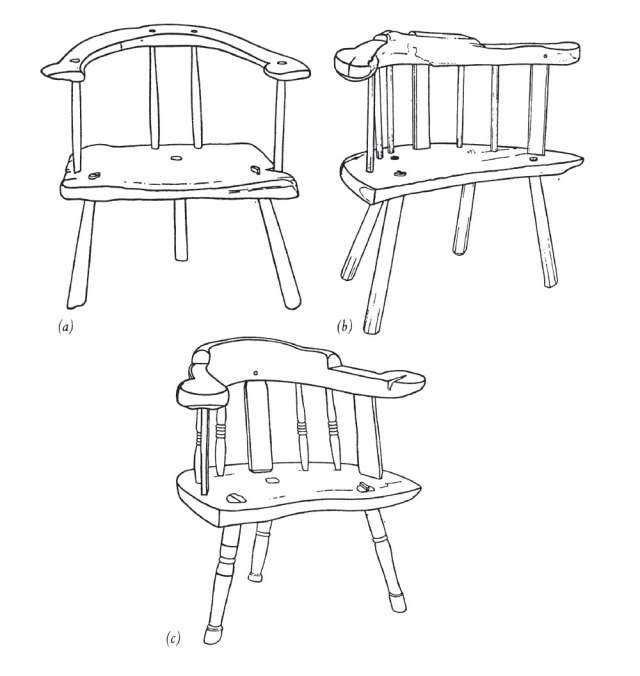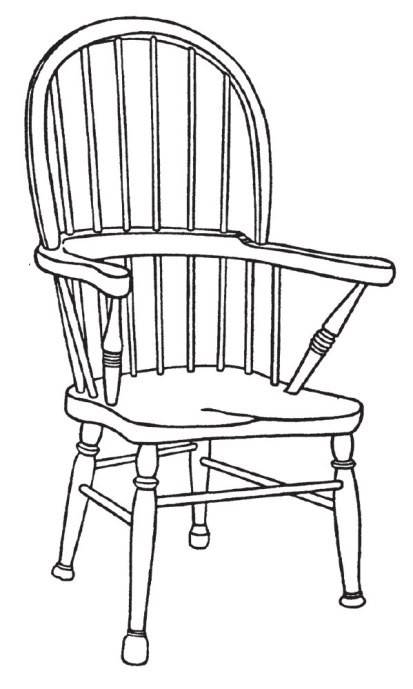
This is an excerpt from “Welsh Stick Chairs” by John Brown.
Tracing the provenance of individual country chairs is a complicated business, probably with few exceptions, impossible. There is no scholarly standard work to refer to. Chairs with similar characteristics are found in different parts of the country (Plate 14). They cannot, with any certainty, be regionalised. Carmarthenshire, with large areas of good farming land and a high proportion of better houses, is known for the quality and elegance of its locally-built furniture. Chairs found in the county, whilst unmistakably Welsh, have a greater sophistication than those made in the more remote parts further north (Plate 20). Dating Welsh stick chairs is very difficult. Whether these Carmarthenshire chairs were made concurrently with their more ‘folk art’ cousins from further north is difficult to say, but it looks as though they might have been. There is the possibility of another regional style. Some Welsh chairs have a wide lozenge- shaped seat, with only three or four untapered, heavier long sticks at the back. This type appears to come from the north (Plate 8, a & c).

As the standard of living improved, throughout Wales primitive furniture and chairs were made. By whom and for whom it is difficult to say. For certain, these items did not find their way into the squire’s house and they were almost entirely rural. The one thing about the chairs is that they all fulfilled the strict definition of ‘Windsor’, in that they grew from a solid wooden seat, having legs and sticks socketed into that seat. The termination of the long back sticks was normally a comb, that is a piece of wood, sometimes curved, sometimes straight, into which the tops of the sticks were mortised. Rarely, a few later chairs have a steamed bow or hoop (Plates 16 & 20). Many of the chairs terminated at the arm, that is the rear sticks did not come up to the level of shoulders or head. These arm-chairs, quite common, are the forerunner of the smoker’s bow or captain’s chair (Plate 14).

What is it that makes these chairs so attractive that now they have become highly sought after collectors’ items? Could it be some extension of the old Celtic art which makes them so appealing? – a naive folk art uncluttered by association with the contemporary urban styles. Many characteristics of the design are extremely good, and represent what we look for today in a well proportioned chair. The most obvious feature is that the legs are set well into the seat with a good rake. The English chair has the legs at the corners, and they are more upright. This is not so elegant. Stretchers to strengthen the legs were sometimes used; there seem to be no rules. When English goods and ideas reached the country village, the rural craftsman was influenced to use some design, and some of the chairs began to lose their spontaneity (Plate 16).

Rural poverty and religious bigotry have triggered much migration of Welsh people, mainly to the New World. In the 1670s, Quakers from Montgomeryshire and Meirionethshire were central to the formation of Pennsylvania. William Penn’s deputy was a Welshman called Thomas Lloyd. Later came the ‘Welsh Tract’ and, in 1786, it was claimed that there were over 900 Welsh Baptist chapels in Pennsylvania and the adjoining states. Welsh shipowners ran a continual service between Pennsylvania and Wales. From north Pembrokeshire and Cardiganshire large scale migrations took place to the Welsh Liberty settlement. Printing in the Welsh language went on in Pennsylvania into this century.

Throughout the United States, Windsor chairs are much more widely seen than in Britain. Furthermore, they are to be found in the best parlours. The class distinction does not exist there. In court-houses and banqueting rooms, hotels and country clubs, American Windsors are in all the best places. There are many unique American-designed Windsors, and the industry or craft started in Pennsylvania. This in itself would not be important were it not for the fact that in two respects American Windsor chairs are similar to Welsh stick chairs. Firstly, there are no splats in the back of either sort. The splat is peculiar to English regional chairs and Wycombe chairs. Secondly, a common feature is the rake, or splay, of the legs. A collector of American chairs, the Reverend Wallace Nutting, wrote a book on the subject in 1917. He illustrates a bow-back English Windsor chair with a pierced splat (Plate 15). Under ‘merit’ he says, “The English Windsors lack grace. Observe how stubby and shapeless the arms are. The bow is very heavy without being stronger for its purpose than a lighter one. The splat is peculiar to the English type. The legs are a very poor feature. They are too nearly vertical, and start too near the corner of the seat for strength or beauty, and their turnings are very clumsy …” The oft repeated statement that American Windsors derive from the English chair could be in error. For historical reasons, and because of similarities in design, there seems to be a more direct link between the Welsh chair and the American Windsor. Perhaps the English version is the cousin, and the Welsh chair is the father!
— Meghan B.